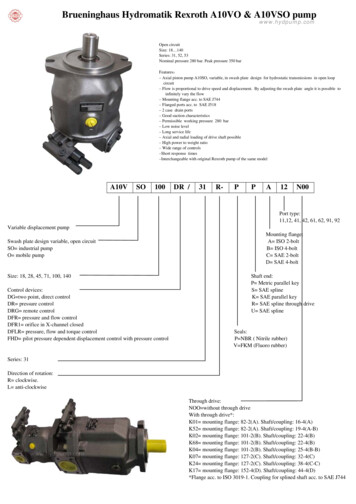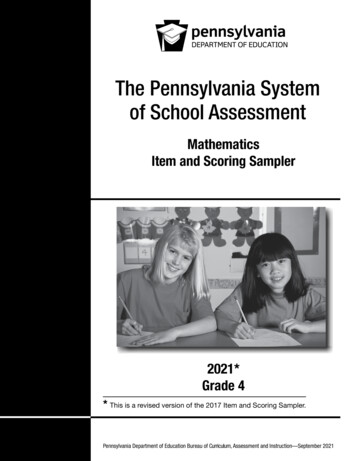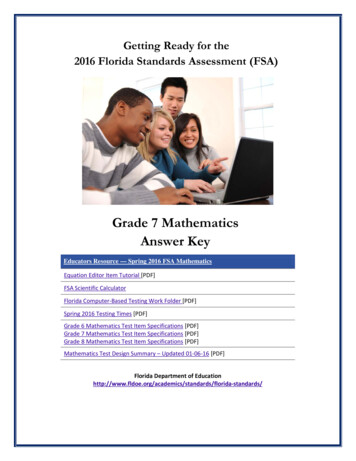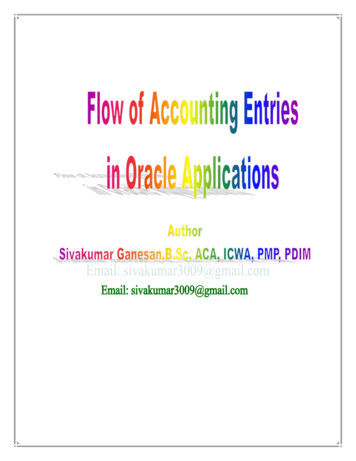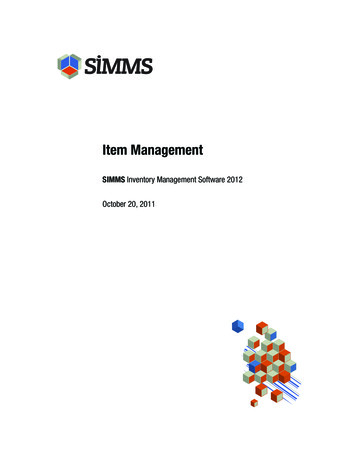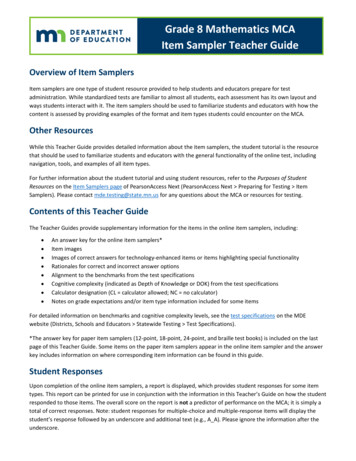
Transcription
Grade 8 Mathematics MCAItem Sampler Teacher GuideOverview of Item SamplersItem samplers are one type of student resource provided to help students and educators prepare for testadministration. While standardized tests are familiar to almost all students, each assessment has its own layout andways students interact with it. The item samplers should be used to familiarize students and educators with how thecontent is assessed by providing examples of the format and item types students could encounter on the MCA.Other ResourcesWhile this Teacher Guide provides detailed information about the item samplers, the student tutorial is the resourcethat should be used to familiarize students and educators with the general functionality of the online test, includingnavigation, tools, and examples of all item types.For further information about the student tutorial and using student resources, refer to the Purposes of StudentResources on the Item Samplers page of PearsonAccess Next (PearsonAccess Next Preparing for Testing ItemSamplers). Please contact mde.testing@state.mn.us for any questions about the MCA or resources for testing.Contents of this Teacher GuideThe Teacher Guides provide supplementary information for the items in the online item samplers, including: An answer key for the online item samplers*Item imagesImages of correct answers for technology-enhanced items or items highlighting special functionalityRationales for correct and incorrect answer optionsAlignment to the benchmarks from the test specificationsCognitive complexity (indicated as Depth of Knowledge or DOK) from the test specificationsCalculator designation (CL calculator allowed; NC no calculator)Notes on grade expectations and/or item type information included for some itemsFor detailed information on benchmarks and cognitive complexity levels, see the test specifications on the MDEwebsite (Districts, Schools and Educators Statewide Testing Test Specifications).*The answer key for paper item samplers (12-point, 18-point, 24-point, and braille test books) is included on the lastpage of this Teacher Guide. Some items on the paper item samplers appear in the online item sampler and the answerkey includes information on where corresponding item information can be found in this guide.Student ResponsesUpon completion of the online item samplers, a report is displayed, which provides student responses for some itemtypes. This report can be printed for use in conjunction with the information in this Teacher’s Guide on how the studentresponded to those items. The overall score on the report is not a predictor of performance on the MCA; it is simply atotal of correct responses. Note: student responses for multiple-choice and multiple-response items will display thestudent’s response followed by an underscore and additional text (e.g., A A). Please ignore the information after theunderscore.
Grade 8 Mathematics MCA Item SamplerOnline Answer KeySection 19 QuestionsItem #CorrectAnswerItem 4.38.2.4.68.2.4.78.3.1.2CLCLCLCLCLCLCLCLCLItem #CorrectAnswerItem NCNCNCNCItem #CorrectAnswerItem LCLSection 210 QuestionsSection 312 Questions
CL*This item demonstrates the straight edge tool that will be available for selectitems on the MCA in grades 8 and 11.
Section 1Question 1Benchmark: 8.2.1.4Understand that an arithmetic sequence is a linear function that can be expressed in theform, whereFor example: The arithmetic sequencecan be expressed as.Item Specifications Vocabulary allowed in items: nth term, arithmetic sequence, geometric sequence,linear function, non-linear function, progression, common difference, and vocabularygiven at previous grades Allowable notation: items must specify the domain asorDOK: 2Calculator: CLAnswer: CABCDMixed up arithmetic with geometric. To find the next term in the sequence,multiply by 2.Arithmetic sequences have the same difference between each consecutive term.This is a growing pattern; the differences areCorrect. To find the next term in the sequence, add.This is a two-rule pattern. The odd-numbered terms use the rule: add; theeven-numbered terms use the rule: add 10.Notes on grade expectations: Student should be able to determine whether a sequenceis arithmetic, geometric, or other by looking at consecutive terms or by findingdifferences. Student should be able to generate terms of a sequence using the given thedomain.
Question 2Benchmark: 8.2.2.2Identify graphical properties of linear functions including slopes and intercepts. Knowthat the slope equals the rate of change, and that the y-intercept is zero when thefunction represents a proportional relationship.Item Specifications Coordinates used for determining slope must contain integer values Vocabulary allowed in items: linear function, intercept, and vocabulary given atprevious gradesDOK: 2Calculator: CLAnswer: BABCDThe weight of each marble is the slope, not the y-intercept.Correct. The y-intercept represents the weight of the jar with 0 marbles in it.The x-intercept—not the y-intercept— is where the weight equals 0. In thissituation, when the x-intercept is 0, the y-value is negative. A negative number ofmarbles is not possible.Mixed up x- and y-axes. The y-intercept represents the weight of the jar with 0marbles in it, not with 10 marbles in it.
Notes on grade expectations: Student should be able to interpret the meaning of points,slope and y-intercept for linear functions in terms of the context.
Question 3Benchmark: 8.2.2.3Identify how coefficient changes in the equationaffect the graphs oflinear functions. Know how to use graphing technology to examine these effects.Item Specifications Vocabulary allowed in items: linear function, intercept, coefficient, constant, andvocabulary given at previous gradesDOK: 2Calculator: CLAnswer: DABCDDid not multiply the change by 4.Used coefficient of 4 from equation.Addedfrom equation.Correct. Since p is multiplied by 4, when p increases by 2, m would increase by.Notes on grade expectations: Student should be able to describe the effect on thedependent variable given a change to the independent variable.
Question 4Benchmark: 8.2.2.5Represent geometric sequences using equations, tables, graphs and verbaldescriptions, and use them to solve problems.atannual interest, she will haveFor example: If a girl investsafter x years.dollarsItem Specifications Vocabulary allowed in items: nth term, arithmetic sequence, geometric sequence,linear function, non-linear function, progression, and vocabulary given at previousgradesDOK: 2Calculator: CLAnswer: CABCDFound the next term (5th) instead of the 7th.Found the 6th term instead of the 7th.Correct. Since the rule is, multiply 40.5 by 3 three times;thFound the 8 term instead of the 7th.Notes on grade expectations: Given consecutive terms of a geometric sequence,student should be able to determine the rule and generate additional terms. Find thecommon ratio by dividing each term by the previous term.
Question 5Benchmark: 8.2.3.2Justify steps in generating equivalent expressions by identifying the properties used,including the properties of algebra. Properties include the associative, commutative anddistributive laws, and the order of operations, including grouping symbols.Item Specifications Items must not have context Vocabulary allowed in items: associative, commutative, distributive, identity,property, order of operations, and vocabulary given at previous gradesDOK: 1Calculator: CLAnswer: CABCDChose incorrect property.Chose incorrect property.Correct. The Distributive Property is shown.Chose incorrect property.
Question 6Benchmark: 8.2.4.3Express linear equations in slope-intercept, point-slope and standard forms, and convertbetween these forms. Given sufficient information, find an equation of a line.For example: Determine an equation of the line through the pointsand.Item Specifications Items must not have context Vocabulary allowed in items: slope-intercept form, point-slope form, standard form,and vocabulary given at previous gradesDOK: 2Calculator: CLAnswer: DABCDMultiplied y by 2 without multiplying any other terms by 2.Multiplied y bywithout multiplying any other terms byDid not multiply y by 2.Correct.Notes on grade expectations: Student should be able to compare equations in differentforms to determine equivalence.
Question 7Benchmark: 8.2.4.6Represent relationships in various contexts with equations and inequalities involving theabsolute value of a linear expression. Solve such equations and inequalities and graphthe solutions on a number line., with aFor example: A cylindrical machine part is manufactured with a radius of. The radius r satisfies the inequalitytolerance of.Item Specifications Vocabulary allowed in items: vocabulary given at previous gradesDOK: 2Calculator: CLAnswer:This is a technology-enhanced item. The correct answer is shown. A student must typethe correct answer in the box in order to receive 1 point.Notes on grade expectations: Solveget.to get. SolvetoNote: The allowable characters that can be entered in the answer box are digits 0-9,fraction bar (/), decimal point (.), and negative sign (-). Students cannot enter a commain numbers with more than 3 digits. Familiarity with calculators will help the students withthis concept.
Question 8Benchmark: 8.2.4.7Represent relationships in various contexts using systems of linear equations. Solvesystems of linear equations in two variables symbolically, graphically and numerically.per month plusper minuteFor example: Marty's cell phone company chargesfor each call. Jeannine's company chargesper minute. Use a system of equationsto determine the advantages of each plan based on the number of minutes used.Item Specifications Vocabulary allowed in items: system of equations, undefined, infinite, intersecting,identical, and vocabulary given at previous gradesDOK: 2Calculator: CLAnswer: BABCDTop equation has x and y mixed up.Correct.Top equation has x and y mixed up. Bottom equation should beBottom equation should be.
Question 9Benchmark: 8.3.1.2Determine the distance between two points on a horizontal or vertical line in a coordinatesystem. Use the Pythagorean Theorem to find the distance between any two points in acoordinate system.Item Specifications Graphs are not provided when finding horizontal or vertical distance Vocabulary allowed in items: Pythagorean Theorem and vocabulary given atprevious gradesDOK: 2Calculator: CLAnswer: CABCDFound square root ofparentheses.Subtracted the squares instead of adding;square root ofbut did not square the.Correct. Square root ofAdded y1 and y2 instead of subtracting;square root of.Notes on grade expectations: Student should be able to find the distance between two22points on a coordinate plane using the distance formula, d (x2 - x1 ) (y 2 - y1 ) , orthe Pythagorean Theorem. Both formulas are on the grade 8 formula sheet.
Section 2Question 1Benchmark: 8.1.1.1Classify real numbers as rational or irrational. Know that when a square root of a positiveinteger is not an integer, then it is irrational. Know that the sum of a rational number andan irrational number is irrational, and the product of a non-zero rational number and anirrational number is irrational.For example: Classify the following numbers as whole numbers, integers, rationalnumbers, irrational numbers, recognizing that some numbers belong in more than one6 3p - 4 , 10 ,category: , , 3.6,.,3 62Item SpecificationsAllowable notation: 18Vocabulary allowed in items: irrational, real, square root, radical, and vocabularygiven at previous grades DOK: 1Calculator: NCAnswer: DABCDThe number is not rational because the square root of 1.5 is an irrational numberand the sum of a rational number and an irrational number is an irrationalnumber.The number is not rational because the square root of 12 is an irrational numberand the difference of a rational number and an irrational number is an irrationalnumber.The number is not rational because the square root of is an irrational numberand the product of a rational number and an irrational number is an irrationalnumber.Correct. The square root of 25 simplifies to 5;
Question 2Benchmark: 8.1.1.2Compare real numbers; locate real numbers on a number line. Identify the square root ofa positive integer as an integer, or if it is not an integer, locate it as a real numberbetween two consecutive positive integers.For example: Put the following numbers in order from smallest to largest:2,,,,.Another example:is an irrational number between 8 and 9.Item Specifications Allowable notation: Vocabulary allowed in items: square root, radical, consecutive, and vocabulary givenat previous gradesDOK: 1Calculator: NCAnswer:This is a technology-enhanced item. The correct answer is shown. A student must selectboth points on the number line in order to receive 1 point.Notes on grade expectations: Student can use knowledge of perfect squares to estimatethe value of. Knowing thatfalls betweenand, and that 1 and 4 are perfectand, so the value ofmust be between 1 and 2.squares, then
Question 3Benchmark: 8.1.1.4Know and apply the properties of positive and negative integer exponents to generateequivalent numerical expressions.2(-5 )(-3 )( )3 3 13 271 .For example: 3 3Item Specifications,,, Allowable notation: Expressions may be numeric or algebraic Vocabulary allowed in items: vocabulary given at previous gradesDOK: 1Calculator: NCAnswer: CABCDDid not square the 4 in parentheses and used division instead of subtraction;.Subtracted unlike terms to get. Dividedbyinstead ofsubtracting.Correct.Cubed the 4 that is not in parentheses; Foundinstead of.Notes on grade expectations: Student should know how to combine like terms and howto use the order of operations from grade 7.
Question 4Benchmark: 8.1.1.5Express approximations of very large and very small numbers using scientific notation;understand how calculators display numbers in scientific notation. Multiply and dividenumbers expressed in scientific notation, express the answer in scientific notation, usingthe correct number of significant digits when physical measurements are involved., but if these numbersFor example:represent physical measurements, the answer should be expressed asbecause the first factor,, only has two significant digits.Item Specifications Vocabulary allowed in items: scientific notation, significant digits, standard form, andvocabulary given at previous gradesDOK: 2Calculator: NCAnswer: DABCDFound exponent usinginstead ofafter rewriting 0.25 as 2.5.Found, but did not rewrite asinstead of subtracting 1.Found, but did not rewrite asCorrect. Did not adjust exponent of 10. Added 1 to exponent of.Notes on grade expectations: Student should know that in scientific notation,the absolute value of a must be greater than or equal to 1 and less than 10.,
Question 5Benchmark: 8.2.1.1Understand that a function is a relationship between an independent variable and adependent variable in which the value of the independent variable determines the valueto represent suchof the dependent variable. Use functional notation, such asrelationships.For example: The relationship between the area of a square and the side length can beexpressed as. In this case,, which represents the fact that asquare of side length 5 units has area 25 units squared.Item Specifications Vocabulary allowed in items: independent, dependent, constant, coefficient, andvocabulary given at previous gradesDOK: 1Calculator: NCAnswer: CABCDFor each x-value, there is only 1 y-value.For each x-value, there is only 1 y-value.Correct. For the x-value of 0, there is more than 1 y-value.For each x-value, there is only 1 y-value.
Notes on grade expectations: Student should know that in a function, there is exactly 1y-value for every x-value. Student should know that the vertical line test may be used todetermine if a graph is a function.
Question 6Benchmark: 8.2.1.2Use linear functions to represent relationships in which changing the input variable bysome amount leads to a change in the output variable that is a constant times thatamount.on the day she was born andon eachFor example: Uncle Jim gave Emilybirthday after that. The functionrepresents the amount of money Jimhas given after x years. The rate of change isper year.Item Specifications Vocabulary allowed in items: independent, dependent, constant, coefficient, andvocabulary given at previous gradesDOK: 1Calculator: NCAnswer: BABCDUsedinstead ofA function of g uses.Correct.Used c instead of g as the independent variable, anddependent variable.Used c instead of g as the independent variable.instead ofas theNotes on grade expectations: Student should know that in a function, the dependentvariable is determined by the independent variable. Using function notation, if theindependent variable is t, then the dependent variable is
Question 7Benchmark: 8.2.2.1Represent linear functions with tables, verbal descriptions, symbols, equations andgraphs; translate from one representation to another.Item Specifications Vocabulary allowed in items: linear function, and vocabulary given at previousgradesDOK: 2Calculator: NCAnswer: CABCDUsedand interpreted y-axis as rate instead of cost.Interpreted axes correctly, but used the pointinstead ofCorrect. The graph has a slope of 5.Thought 40 was the y-intercept.Notes on grade expectations: Student should be able to interpret the meaning of points,slope, and y-intercept in linear function in terms of the context.
Question 8Benchmark: 8.2.4.4Use linear inequalities to represent relationships in various contexts.For example: A gas station chargesless per gallon of gasoline if a customer alsogets a car wash. Without the car wash, gas costsper gallon. The car wash is. What are the possible amounts (in gallons) of gasoline that you can buy if youalso get a car wash and can spend at most?Item Specifications Inequalities contain no more than 1 variable Vocabulary allowed in items: vocabulary given at previous gradesDOK: 1Calculator: NCAnswer: BABCDReversed inequality symbol.Correct.Mixed up x and y. Reversed inequality symbol.Mixed up x and y.
Question 9Benchmark: 8.3.2.1Understand and apply the relationships between the slopes of parallel lines and betweenthe slopes of perpendicular lines. Dynamic graphing software may be used to examinethese relationships.Item Specifications Vocabulary allowed in items: vocabulary given at previous gradesDOK: 2Calculator: NCAnswer:This is a technology-enhanced item. The correct answer is shown. A student must selectboth of the correct equations in order to receive 1 point.Notes on grade expectations: Student should know that perpendicular lines haveopposite reciprocal slopes. In this situation, since the slope of the given line is , selectequations with slope of.
Question 10Benchmark: 8.3.2.2Analyze polygons on a coordinate system by determining the slopes of their sides.For example: Given the coordinates of four points, determine whether the correspondingquadrilateral is a parallelogram.Item Specifications Vocabulary allowed in items: vocabulary given at previous gradesDOK: 3Calculator: NCAnswer: AACorrect. The slope of the given line is , so the other sides must have the sameslope (parallel sides) or the opposite reciprocal slope,BHas slope of 3 instead of orCHas slope ofDHas slope of 2 instead of or(perpendicular sides).instead of or.Notes on grade expectations: Student should know definitions of polygons from previousgrades. Rectangles have 2 sets of parallel sides. Since rectangles have 4 right angles,the sets of sides are perpendicular to each other. Student should know that parallel lineshave equivalent slopes and perpendicular lines have opposite reciprocal slopes.This item is DOK 3 because several decisions are required before proceeding. Studentmust understand the relationships between the slopes of the sides of a rectangle.Students must be able to determine the slope of the line represented by the givenequation; this most likely requires changing the equation into slope-intercept formThen students will determine what the slopes of the parallel andperpendicular lines could be and find an equation containing those.
Section 3Question 1Benchmark: 8.2.1.3Understand that a function is linear if it can be expressed in the formor if its graph is a straight line.For example: The functionis not a linear function because its graph containsthe pointsandwhich are not on a straight line.Item Specifications Vocabulary allowed in items: linear, constant, coefficient, and vocabulary given atprevious gradesDOK: 1Calculator: CLAnswer:This is a technology-enhanced item. The correct answer is shown. A student must placeeach relationship into the correct box in order to receive 1 point.
Notes on grade expectations:A relationship is linear if:, or· the equation can be expressed in the form:· the graph is a straight line, or· the greatest exponent of the independent variable in the equation is 1A relationship is nonlinear if:· the equation can be expressed in a form other than, or· the graph is not a straight line, or· the greatest exponent of the independent variable in the equation is greater than1
Question 2Benchmark: 8.2.1.5Understand that a geometric sequence is a non-linear function that can be expressed in, wherethe formFor example: The geometric sequencecan be expressed in the form).Item Specifications Vocabulary allowed in items: nth term, arithmetic sequence, geometric sequence,linear function, non-linear function, exponential, progression, common ratio, andvocabulary given at previous grades Allowable notation: items must specify the domain asorDOK: 2Calculator: CLAnswer: DABCDEquation is not in the form. The termshave a commondifference (arithmetic sequence), not a common ratio.Confusedwith . There is no common ratio between the termsConfusedwith . There is no common ratio between the termsCorrect. Equation is in the form. The terms in the sequence,can be generated using a common ratio of 2 (i.e.,,, etc.).,Notes on grade expectations: Student should be able to determine whether a sequenceis arithmetic, geometric, or other by looking at the equation or consecutive terms in thesequence. A geometric sequence has a common ratio between consecutive terms.
Question 3Benchmark: 8.2.2.4Represent arithmetic sequences using equations, tables, graphs and verbaldescriptions, and use them to solve problems.in savings and addsat the end of each month,For example: If a girl starts withshe will havedollars after x months.Item Specifications Vocabulary allowed in items: nth term, arithmetic sequence, geometric sequence,linear function, non-linear function, progression, and vocabulary given at previousgradesDOK: 2Calculator: CLAnswer: DABCDFound constant difference of, then attempted to write as a recursive formula.Ignored initial term in sequence; only used change (slope).Mixed up slope and y-intercept.Correct. Constant difference ofequals slope; useor find 0thterm to find y-intercept of 5.Notes on grade expectations: Student should be able to determine whether a sequenceis arithmetic, geometric, or other by looking at consecutive terms or by findingdifferences. Student should be able to write a function rule for the sequence.
Question 4Benchmark: 8.2.3.1Evaluate algebraic expressions, including expressions containing radicals and absolutevalues, at specified values of their variables.For example: Evaluate pr 2 h whenand, and then use an approximationof to obtain an approximate answer.Item Specifications Items must not have context Directives may include: simplify, evaluate Vocabulary allowed in items: vocabulary given at previous gradesDOK: 2Calculator: CLAnswer: BABCDMay have ignoredCorrect.Mixed upsign.May have ignoredand calculatedand absolute value signs calculatingNotes on grade expectations: Student should know the order of operations from previousgrades.
Question 5Benchmark: 8.2.4.1Use linear equations to represent situations involving a constant rate of change,including proportional and non-proportional relationships.For example: For a cylinder with fixed radius of length 5, the surface area, is a linear function of the height h, but the surfacearea is not proportional to the height.Item Specifications Vocabulary allowed in items: vocabulary given at previous gradesDOK: 2Calculator: CLAnswer: CABCDCombinedas.For beans, used 1 row instead of 1 rowplants.Correct.Thought there were 5 rows of n tomatoes and 1 row of beans with 3 plants ineach row.
Question 6Benchmark: 8.2.4.2Solve multi-step equations in one variable. Solve for one variable in a multi-variableequation in terms of the other variables. Justify the steps by identifying the properties ofequalities used.can be changed to, and thenFor example: The equationtoby adding/subtracting the same quantities to both sides. These changesdo not change the solution of the equation.Another example: Using the formula for the perimeter of a rectangle, solve for the basein terms of the height and perimeter.Item Specifications Vocabulary allowed in items: vocabulary given at previous gradesDOK: 2Calculator: CLAnswer: AABCDCorrect.;;Subtracted 2 from both sides instead of dividing by 2; treatedAdded 10 to both sides instead of subtracting.Multiplied both sides by 2 instead of dividing by 2.as.
Question 7Benchmark: 8.2.4.5Solve linear inequalities using properties of inequalities. Graph the solutions on anumber line.For example: The inequalityis equivalent to, which can berepresented on the number line by shading in the interval to the right of.Item Specifications Vocabulary allowed in items: vocabulary given at previous gradesDOK: 2Calculator: CLAnswer: BABCDReversed inequality symbols.(multiplied by).Correct. Equivalent toDid not reverse inequality symbols when multiplying by negative number.Reversed inequality symbols.
Question 8Benchmark: 8.3.1.1Use the Pythagorean Theorem to solve problems involving right triangles.For example: Determine the perimeter of a right triangle, given the lengths of two of itssides.Another example: Show that a triangle with side lengths 4, 5 and 6 is not a right triangle.Item Specifications Congruent angle marks may be used Vocabulary allowed in items: Pythagorean Theorem and vocabulary given atprevious gradesDOK: 2Calculator: CLAnswer:This is a technology-enhanced item. The correct answer is shown. A student must typethe correct answer in the box in order to receive 1 point.
Notes on grade expectations: Student finds the hypotenuse using the PythagoreanTheorem:Note: The allowable characters that can be entered in the answer box are digits 0-9,fraction bar (/), decimal point (.), and negative sign (-). Students cannot enter a commain numbers with more than 3 digits. Familiarity with calculators will help the students withthis concept.
Question 9Benchmark: 8.3.2.3Given a line on a coordinate system and the coordinates of a point not on the line, findlines through that point that are parallel and perpendicular to the given line, symbolicallyand graphically.Item Specifications Vocabulary allowed in items: vocabulary given at previous gradesDOK: 2Calculator: CLAnswer: B
ABCDSlope is correct, but this line does not go through the point, then usedCorrect. Found opposite reciprocal of slope,y-intercept.Used reciprocal of slope, but did not use the opposite sign.Used reciprocal of slope, but did not use the opposite sign.Notes on grade expectations: Student should know from previous grades thatperpendicular lines have opposite reciprocal slopes.to find
Question 10Benchmark: 8.4.1.2Use a line of best fit to make statements about approximate rate of change and to makepredictions about values not in the original data set.For example: Given a scatterplot relating student heights to shoe sizes, predict the shoestudent, even if the data does not contain information for a student of thatsize of aheight.Item Specifications Vocabulary allowed in items: scatterplot, line of best fit, and vocabulary given atprevious gradesDOK: 2Calculator: CLAnswer: BABCDThe scatterplot does not list all Ferris wheels; this statement cannot beconfirmed.Correct. Slope of line confirmsper 10 years or.Only some, not all, of the newer Ferris wheels were taller.The number of data points per year does not perpetually increase.
Notes on grade expectations: Student should be able to interpret a scatterplot and theline of best fit in terms of the context.
Question 11Benchmark: 8.2.1.2Use linear functions to represent relationships in which changing the input variable bysome amount leads to a change in the output variable that is a constant times thatamount.on the day she was born andon eachFor example: Uncle Jim gave Emilybirthday after that. The functionrepresents the amount of money Jimhas given after x years. The rate of change isper year.Item Specifications Vocabulary allowed in items: independent, dependent, constant, coefficient, andvocabulary given at previous gradesDOK: 3Calculator: CLAnswer:This is a technology-enhanced item. The correct answer is shown. A student must checkboth boxes in order to receive 1 point.
Notes on grade expectations: Students may recall generic rules about working withnegative numbers and numbers between 0 and 1, but in this item they must determinewhat rule to apply. The item uses only variables and therefore does not supply cueing forthe student. page
Grade 8 Mathematics MCA Item Sampler Teacher Guide Overview of Item Samplers Item samplers are one type of student resource provided to help students and educators prepare for test administration. While standardized tests are familiar to almost all students, each assessme
